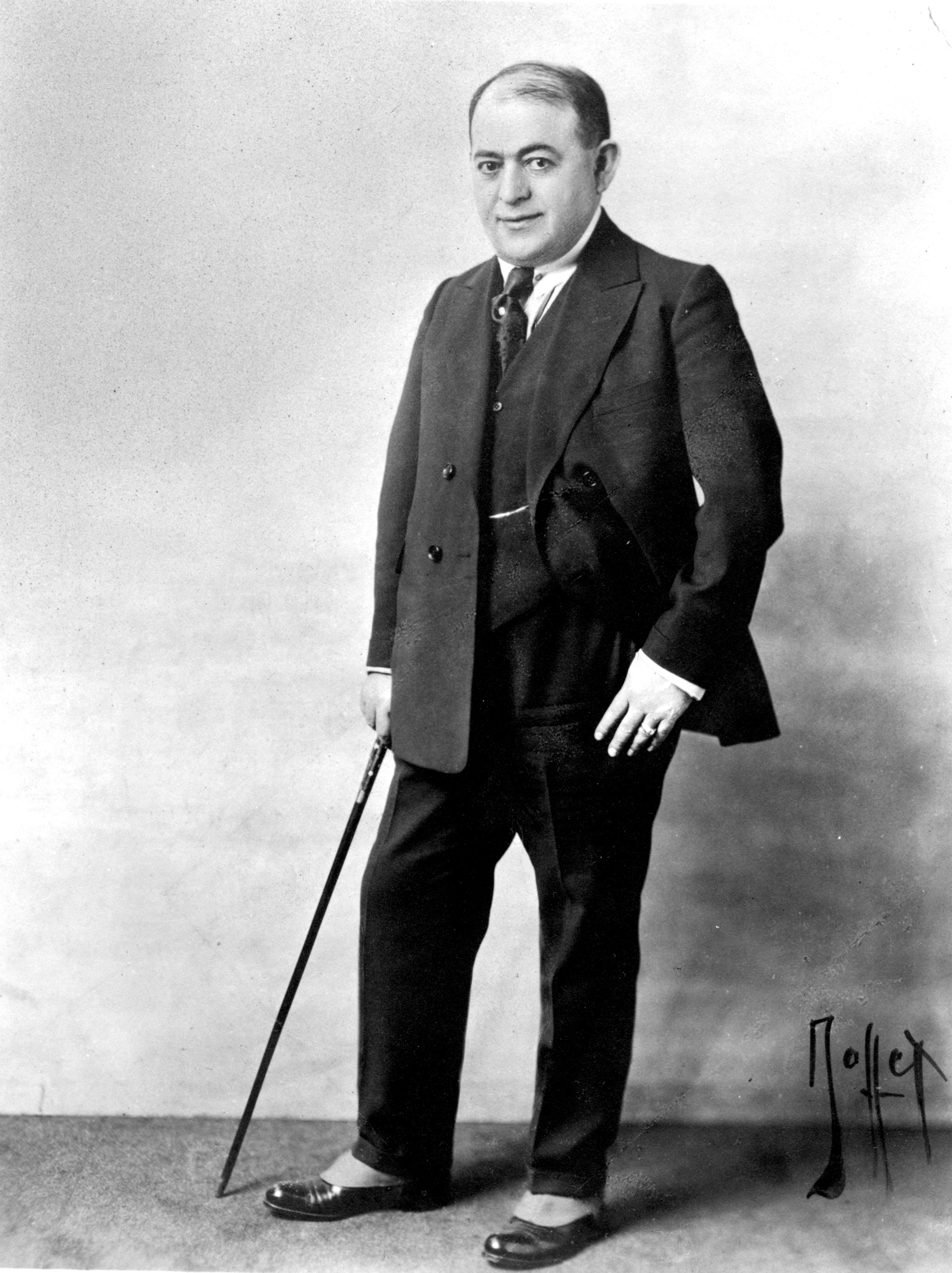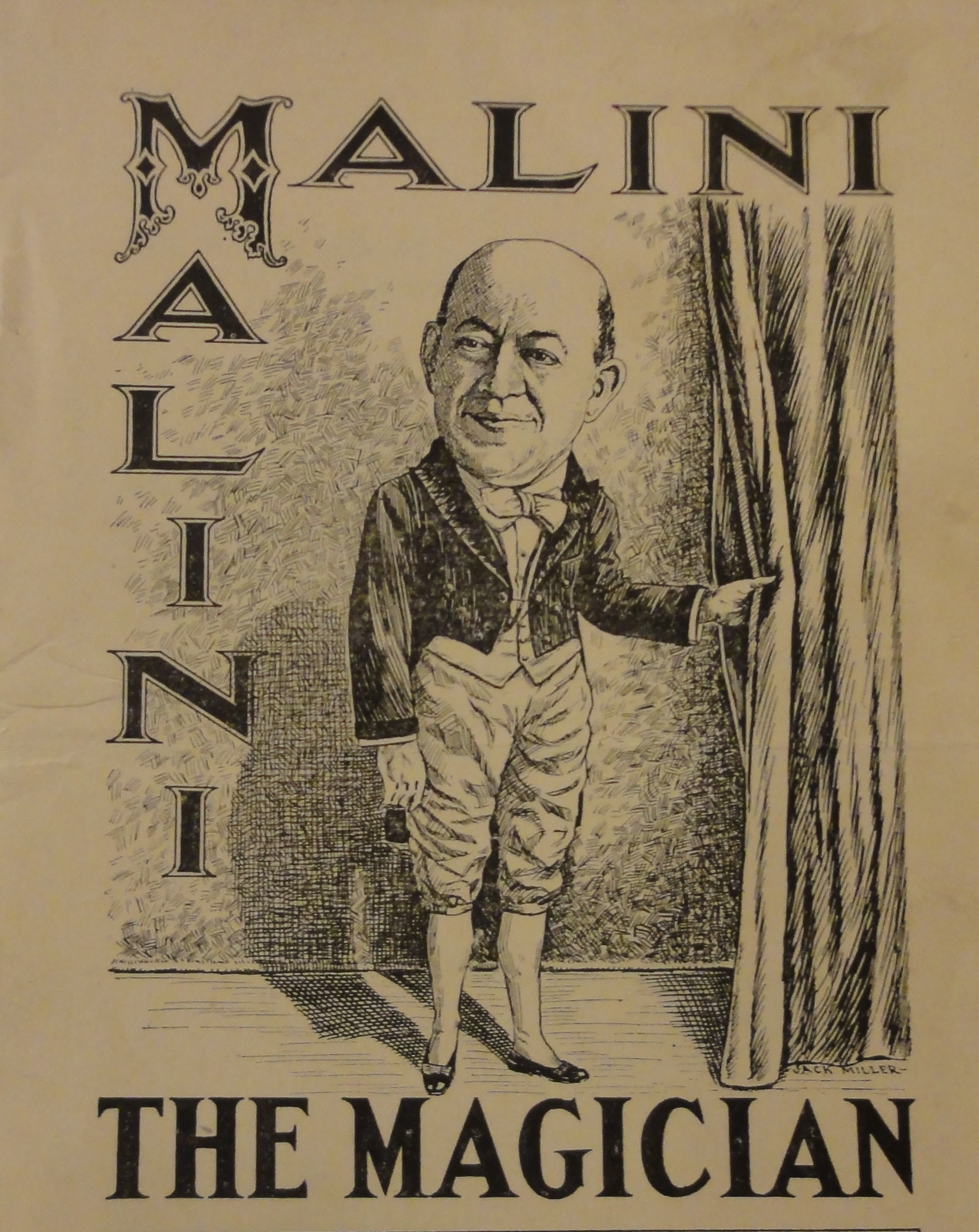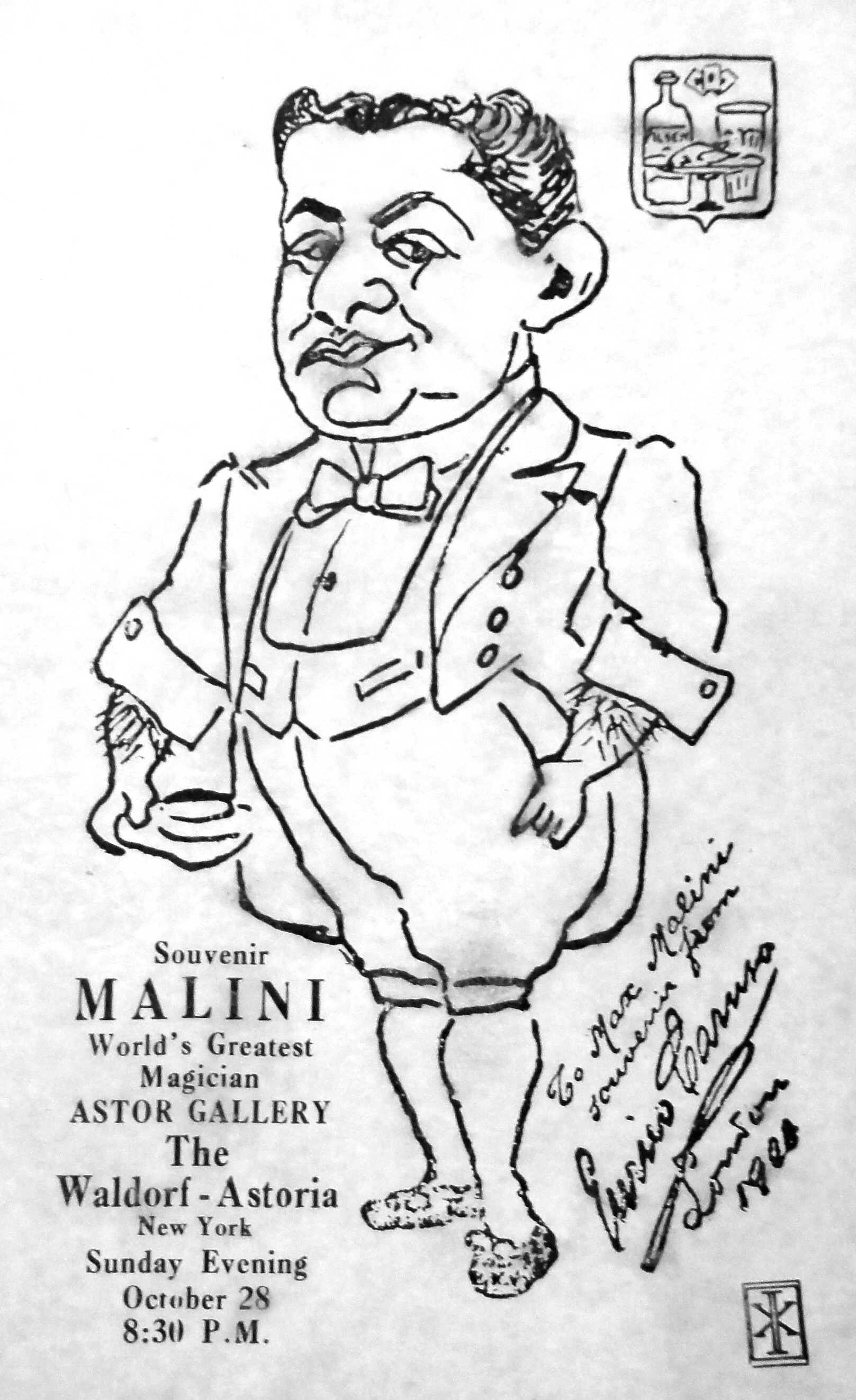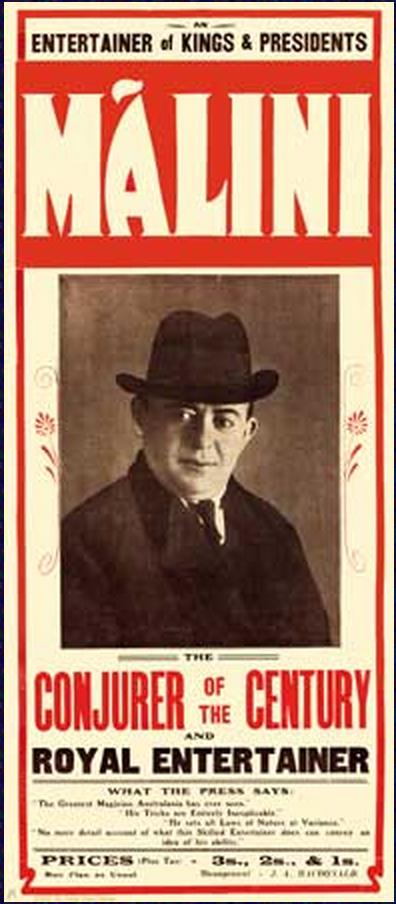MAGIC MENTOR MONDAY: Max Malini
October 5, 2015
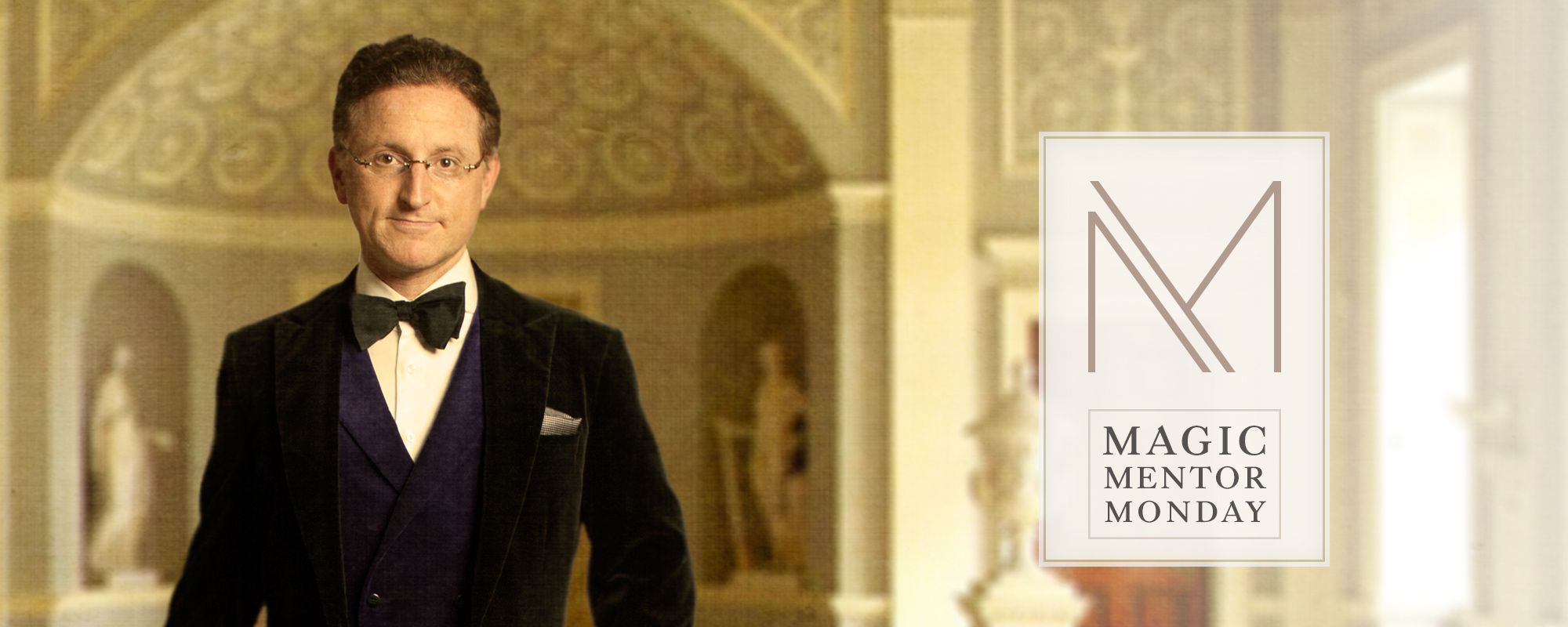
Welcome to MAGIC MENTOR MONDAY. In this weekly series, I introduce you to my magic mentors – people who have inspired me to become a better magician. Each Monday you’ll meet someone who has offered advice, or acted by example, to help steer my career.
Some of these people are alive, others no longer with us. Some are famous, others not so much. The beauty of mentorship is that you don’t necessarily have to meet your mentor face-to-face, nor even live during the same time in history. Many of the people who inspired me were alive a century before I was born! By reading classic books, old newspapers, and magazine articles, I’ve tracked down stories about their lives and work that continue to motivate me to become a better entertainer.
My “big three” mentors are Max Malini, Johann Nepomuk Hofzinser, and Jean Eugene Robert-Houdin. Each of these giants will be featured in coming weeks. You’ll also read about contemporary figures like Harry Lorayne and Albert Goshman, non-magicians Danny Kaye and Sammy Davis, Jr. and even fictional characters like Willy Wonka.
How do mentors inspire? They set examples, helping us imagine how we too might solve a particular problem. By seeing the world through a mentor’s lens, we can learn more about them, and about ourselves, at the same time.
Ready? Let’s begin with my number one greatest inspiration:
MAX MALINI
Imagine this. It’s 1905, over one hundred years ago. You’re attending a fancy charity event at a Park Avenue apartment. Looking around, you recognize boldface names from the newspaper’s society column – Vanderbilt, Carnegie, and Astor. Anyone who is anybody seems to be there. A short, gruff looking guest arrives suddenly at the door wearing a thick overcoat. His odd appearance draws the attention of the room. Without speaking, the stranger pulls a hand drill out from his coat, walks to the wall, and drills a hole in it. Wood shavings from the wall fall to the ground in a pile at his feet. He reaches into his pocket, removes a metal hook, and sticks it into the freshly bored hole. At last, the odd man doffs his overcoat, and hangs it on the hook. He faces the crowd and announces in a gravely, thick Eastern European accent, “Ladeez and genteelmen, goot evening. I’m Malini the Machician.”
For the next several hours, Malini baffles the guests with impossible-looking sleight of hand tricks, and seemingly unplanned miracles. At the end of the night, after gathering his sizable paycheck, Malini walks to the front door, removes his hanging coat, pulls the hook out of the wall, and leaves. To everyone’s amazement, the hole that was drilled in the wall is now gone!
This story, a true one told to me by a relative of Max Malini, is one of many that demonstrates the extent of his brilliance. His performances were the stuff of which legends are made.
Born in Austria, Malini emigrated as a boy to the United States in 1887 or 1888, settling in New York City. Working at saloons on the Bowery for tips, he began a new life with nothing but his skill and quick wit. Eventually Malini rose to the pinnacle of show business, making (and spending) several fortunes in his lifetime. During his career, Malini entertained several U.S. Presidents, gave command performances in Buckingham Palace, and received gifts from monarchs in Europe and Asia.
After traveling the world, he lived and performed in the original Waldorf Astoria hotel, located on 34th Street and Fifth Avenue in New York (the current location of the Empire State Building). In one of his signature tricks, Malini produced a solid brick from inside a borrowed hat. This brick was placed on display in the lobby of the original Waldorf, presented in a glass display case. A museum card at the front of the case read: “Brick produced from an empty hat by magician Max Malini.” Given my own personal fascination with Malini, I was determined to locate this brick so that I could use it in my own shows at the Waldorf Astoria. Alas, it was lost during the demolition of the original hotel.
Over the years, I’ve tracked down other Malini materials for my own personal collection, including Malini’s business card, a ticket to one of his public shows, a rare advertising booklet, a playing card he handled in performance, and a hand-signed portrait. I was also delighted to hold Malini’s gloves and shoes when I visited David Copperfield’s museum in Las Vegas.
During a trip to Hawaii, I made a pilgrimage to Malini’s house in Honolulu, stood in his garden, and retraced the steps to many of his old stomping grounds. I even stepped onto the stage where he performed, at the Royal Hawaiian hotel. Click here for an in-depth photoessay.
What is it about Max Malini that fascinates me? Why do magicians still speak reverently of Malini today, nearly 75 years after his death?
In my opinion, Malini personified some ideal characteristics of what a magician should be. Here are some lessons he taught me:
TRAVEL LIGHT, BUT ALWAYS BE READY
Malini carried no visible apparatus, but produced or borrowed objects as needed for his performances. Even the tables he worked on were borrowed from the hotel or club where he appeared. Once asked by another magician about his approach, Malini replied, “Vot the hell you vant to cart all dat junk around for? Do it de easy vay.”
Malini made his reputation outside of the theaters, performing close-up tricks in private clubs and lobby lounges. He was always loaded with something to produce, whether a red brick or a head of cabbage. Before a show in someone’s private home, he would stop into the kitchen and load his pockets with various fruits that he would later reveal under cups or inside a lady’s purse.
That’s the first of Malini’s lessons – travel light, but always be ready. Instead of performing the classic Cups and Balls with specially balanced silver cups manufactured for the sole purpose of this trick, Malini borrowed three kitchen glasses. Instead of balls he used three medicine bottle corks. A butter knife became his magic wand. In front of the audience, Malini covered each glass with a square of newspaper so that nobody could see inside. He proceeded to perform the trick, apparently “off the cuff.” The impromptu nature of the props made his practiced handling that much more disarming to the audience. They had no chance of seeing him manipulate the pieces of cork as they jumped among the cups. And the fruit he had previously stolen from the kitchen made a surprising appearance at the end: one lemon under each cup.
FOCUS ON SHOWMANSHIP
Malini was not a particularly talented manipulator, or a crack card man. However, according to David Bamberg, Malini was a master showman: “Some of the card moves I saw him do were the crudest things imaginable, but no one noticed as his acting ability covered up for him.”
Roy Benson agreed that Malini was a superb showman – on par with Houdini even – who had a fine sense of the dramatic and never hesitated to use it. Malini could dramatically build each trick to a startling climax.
It’s possible to take the smallest trick, the vanish of a gold coin from within a folded sheet of paper, for example, and expand it into a great mystery. The mechanics of the trick itself may not be particularly intricate, but the lead-up, the presentation, the audience by-play must be engaging and fun. When Malini sat with a crowd, something was always happening: a funny story, an amusing compliment, an impromptu game of dice. He kept audiences on their toes, by changing up the moment with seemingly irrelevant stories that would have a big payoff at the end.
Here is some verbatim patter that Malini used during his stage show, immediately before vanishing a large bowl of water:
“Dis trick vot I am going to do now I vos teached in China. I don’t need no big stage and a lot of assistants and fancy scenery to do it. I admit I ain’t Chesus Christ but I’m better dan a lot of oders vot call themselves machicians.”
What a character! If I were in that audience, I know that I’d be on the edge of my seat.
This reminds me of advice given by David Berglas: when performing magic, “the order of importance is personality, presentation, and finally the method.” The one thing on this list that can’t be taught is personality.
AIM HIGH
Malini was an unabashed gate-crasher. Dressed to the nines, he walked uninvited into private clubs, found the most important person in the room, and introduced himself as the greatest magician in the world. Malini quickly performed some fascinating tricks and ingratiated himself to the high-ranking member and his friends. Invariably they would invite him to stay at the club for supper and drinks. This often led to invitations for him to perform privately at their swanky homes and mansions. He repeated this modus operandi in Hong Kong, Shanghai, Buenos Aires, San Francisco, Chicago, and across Europe. It clearly worked for him.
Early in my career I took Malini’s behavior to heart. When I was twenty-three, I scheduled weekly visits to the Peninsula Hotel, one of New York’s most elegant hotels. Each Wednesday I sat in the bar lounge, chatted with other patrons over a few drinks, and showed them magic – free of charge. Nobody invited me there, and it was not a paying gig. It was simply my way of emulating Malini’s self-introduction. Some of the people I met in the lounge politely asked me to leave. Others, however, booked me privately for high-end events in castles, and on private islands. This was an eye-opener! I was suddenly launched into a world I had only imagined. The management of the Peninsula eventually got word of my unauthorized appearances, asked me to stop, and called me in to speak with their manager. Instead of being reprimanded, he introduced me to the Catering Director, who booked me for dozens of corporate shows and weddings at the Peninsula, thus launching my career as a society entertainer in New York.
While Malini performed stage shows for audiences of several hundred people, his specialty was performing at a bar or table. David Bamberg writes: “Much has been written about his misdirection, but for me he had something that surpassed that. He was never in a hurry and would wait patiently his chance to spring unawares.”
Malini allegedly once had a conversation with another magician about misdirection. The magician wanted to know how Malini, with his tiny and pudgy hands, was able to execute a secret card sleight without being caught. Malini explained, “You vait until they look up.” The other magician asked what he would do if the audience didn’t look up. What would happen, he asked, if they continuously stare at your hands? Malini answered, “You vait a veek!”
While this legendary story may be apocryphal, it illustrates the need to be vividly aware of your audience. Each audience member is a living, breathing individual, looking at a different spot, from a different angle, with the intent to “catch” the performer. If the magician places focus on his own hands, and the importance of the props he’s holding, so will the audience. They have no choice. The key is to make the performance about something larger. If you present something that is more engaging, the audience will look away from your hands, naturally. Because they’re human. And humans are interested in other humans. In Chamber Magic, nobody catches my sleights because each move is executed when the focus is elsewhere. I “vait” until someone responds to a question that everyone wants to hear. I “vait” until someone stands up to move next to me. I “vait” until a joke’s punchline registers, since the audience can’t laugh and pay close attention to my hands at the same time. If necessary, I’ll vait a veek and a half.
BE BOLD
It takes guts to pull off the kinds of tricks that Malini was known for. He threw a glass of whiskey into the air, and it vanished mid-throw. He yanked a button off of someone’s jacket, and later magically reattached it. He got into people’s personal space and didn’t feel guilty about it. One of Malini’s card routines described in The Vernon Chronicles explains that he would grab a spectator by the shoulders and adjust how they were standing, while performing a secret move at that exact moment. He wasn’t scared or deferential to his audiences. And it didn’t matter who he was performing for. When appearing before the King of England, he was instructed to bow deeply and address the leader as “your highness.” In his inimitable way, Malini skipped the bow, came in close to share a cigar, and called the King, “Royal Mister.” This brash attitude broke the ice, and allowed Malini to engage the King on his own terms.
I recalled this story when I performed for the Crown Prince of Saudi Arabia, in New York. The Saudi liaison told me that if the Crown Prince gets tired, they would give me a signal to stop at once. The liaison asked me how long my performance would be. Typically, the show runs 60 minutes, but I figured that since we started late I shouldn’t go on too long. The liaison suggested I aim for 20 minutes, and see how the Crown Prince liked it.
I was given a brief lesson in protocol, and was instructed to address the Crown Prince as “Your Majesty.” And, I was instructed not to walk within ten feet of his throne.
By the end of the night, I had performed for 55 minutes, and was standing 18 inches from his nose.
Conclusion
In order to yield maximum growth in the shortest amount of time, it makes sense to model yourself after someone who has already achieved the goals you desire. In my case I wanted to become a successful drawing-room and private entertainer, so I modeled my career and my magic after Max Malini, the greatest of them all.
The next routine I’m adding to my show was refined and popularized by Malini: the Blindfolded Card Stab. It is a masterpiece of magic and showmanship that I can’t wait to share with my audiences.
On a more personal level, I had the rare opportunity to stand in the garden where Malini died, and later tracked down and interviewed the man who held him in his arms as Malini took his final breath. While Malini has passed on (dying in 1942 in Honolulu), his spirit is still alive each time I step on stage. He is my role model and shining star of the type of magician I strive to be.
Next week: CHARLES BERTRAM
For further study, I recommend the following books and magazines.
- Malini and His Magic, by Dai Vernon. Edited by Lewis Ganson
- Learned Pigs and Fireproof Women, by Ricky Jay. Chapter 6, “Max Malini: The Last of the Mountebanks”
- Genii Magazine, November 1999. Issue dedicated to Malini
- Genii Magazine, October 2012. Issue dedicated to Malini
- The Annals of Conjuring, by Sidney W. Clarke. Pages 356-357
- Roy Benson By Starlight, by Levent and Todd Karr. Pages 426-428
- Stars of Magic, “Vernon on Malini.” Pages 150-157
- Illusion Show, by David Bamberg. Pages 186-189
- The Sphinx, many references throughout the entire run of this magazine
- The Malini Story, published in The Conjuror’s Magazine, Walter B. Gibson.
- Okito on Magic, by Theodore Bamberg. Pages 38-41, and 90-92
- “We Knew Max Malini,” narrated to George C. Kaplan. Hugard’s Magic Monthly, Vol. 9
I’ve also written numerous original articles about Malini on this blog:
- Max Malini’s Advertising Booklet, ca. 1926
- Max Malini and Two-Gun Cohen
- Max Malini Newspaper Article – San Francisco Call, May 18, 1912
- A Visit to Max Malini’s House in Honolulu
- Max Malini’s Calling Card
- Did You Know? Magicians at the Waldorf, 1902~present
